#taylor swift yntcd
Explore tagged Tumblr posts
Text







TAYLOR SWIFT: THE ERAS TOUR YOU NEED TO CALM DOWN
#taylor swift#the eras tour#lover#taylorswiftedit#you need to calm down#yntcd#tswiftedit#the eras tour film#tswiftgif#tscreators#tstheerastour#filmtv#dailyfilmsource#dailytvandfilm#dailyfilmtvgifs#*mine#*tsedit
813 notes
·
View notes
Text


hamburg n2
#taylor swift#the swiftie tag#userrcmanticpoetry#tswiftedit#tscreators#tswiftgif#networkthirteen#tswiftdaily#usertaylorswiftdaily#mine.#tegan .gif#hamburg n2#song: yntcd#yntcd#you need to calm down#era: lover#lover#era: eras#the eras tour#100.#200.
264 notes
·
View notes
Text






Every Taylor Swift Music Video -> You Need To Calm Down
#every taylor swift mv series*#taylor swift#my edit#my gifs#tswift#tswiftedit#you need to calm down#lover#lover album#yntcd#tswiftdaily#tswiftgif#candy swift#taylor swift gifs#taylor swift edit#tsusermeggie#tsuserkatie#tsuseraugust#userjake#tsusermels#tsuserjam#tsuserannie#tusertaylor#hauntedbythelook#usergoose#userkarolina#tw fire
194 notes
·
View notes
Text


5 years ago today, Taylor Swift went live on Instagram and announced her 7th studio album ''Lover''
She also announced her second single ''You Need To Calm Down''
284 notes
·
View notes
Note
if you ever did an in-depth post about ‘you need to calm down’ i would love to see it because that is my most-hated taylor swift song. like why are you comparing your beef with katy perry to homophobia 😭😭😭
As a lesbian- I have a lot of feelings pent up about "You Need to Calm Down" and all of them are negative.
At the songs core- Swift is showing herself to be horribly ignorant. Are we really all going to accept her propping up the idea that homophobia is the same as having a public disagreement with another celebrity? Not only is she negating the power dynamics that often exist within the propagation of homophobia, by insinuating that homophobia is the same as a disagreement between equals in society, but she is also trivializing it down to a simple disagreement over career related bullshit.
Not to mention that she is NOT an ally- I cannot stand the people who think she is a left-leaning, feminist, LGBT advocate. It's like they have created a fanfiction concept of Taylor Swift in their heads.
She profits off the LGBT community when it is most beneficial- but when legitimate rights are being stripped away, she is silent.
Taylor Swift is really good at commodifying social trends without actually risking anything. She waits until it is safe- then pretends to speak up for people's rights, when, in reality, she is just finally able to turn the social trend into part of her brand. Therefore, she gave a stupid line in the song "Welcome to New York" (2014) about how New York City is somehow a utopia of gay freedom (not true but whatever), and then in "You Need to Calm Down" she was profiting off the excess of emotion and democratic enterprising seeping off the US Election cycle.
Her first use of this profit-first tacit happened in 2014- what happened in 2015? The US supreme court legalized same-sex marriage. Swift simply saw the social trend- and captialized off a topic about which the youth were passionate.
The second time, in "You Need to Calm Down" she published this song in 2019- firmly within her faux activist era, and well-aware that the youth were interested in politics. This was right before the 2020 US election- she once again saw the increase of young people paying attention to the ideological split within the country- bearing in mind her target audience skews young, progressive, and American, she pounced on the opportunity to capitalize off their impulse towards supporting ideological-progressive media. As we all geared up to vote down the conservative-leaning Donald Trump, who aligned himself with right-wing religious ideologies standing to threaten the previous supreme court decision on Same-Sex rights, Swift swoops in with a silly pop-beat and a fake country accent to pretend she is the savior of the young and gay.
If it wasn't so shady- it would be a brillant use of rhetorical analysis to sell product. Capitalism has made a cynic of me- I fear.
Swift saw the fear of young LGBT people- during an election cycle-and decided to profit off that fear not through distancing herself from them, but by pretending to care. Notice, again, how she only mentioned gay rights during these very specific cultural conditions which allow her to somehow make a profit off ideologically aligning herself with one side of an issue or another.
Personally, I find fake care even more heinous than outright hatred.
Once again- in this current year she is using the endorsement of a US presidential candidate to further her own brand and try to re-affirm her place within the general rhetorical circles of "progressive and therefore morally upstanding individual" to the youth.
It's all a calculated move to shake-off whatever negative press she got through her associations with right-wing Footballers and keep her prime audience of young Americans.
I have much more to say on this topic- but for now, this is where I leave you. I have to go eat lunch.
#anti taylor swift#ex swiftie#taylor swift critical#anti swifties#ttpd#taylor swift#us elections#rhetorical situation#you need to calm down#welcome to new york#yntcd#lgbt rights#lgbt#progressivism#leftism#rhetoric#lover era#1989 era
124 notes
·
View notes
Text
The A to Z of Plausible Deniability: Taylor Swift’s 2019 Vogue Interview, Decoded
https://www.vogue.com/article/taylor-swift-cover-september-2019
Hey Kids! Spelling Is Fun!
There are a few moments in Taylor Swift’s career that fans point to as definitive—words etched in stone, used to silence entire communities of listeners. Chief among them? One quote from her 2019 Vogue cover story, often held up as the nail in the coffin of Gaylorism. And yet, as with everything in Swift’s world, what seems like a clear declaration rarely is.
When she said, “I didn’t realize until recently that I could advocate for a community I’m not a part of,” many saw it as a disavowal.
But those of us who’ve studied her work closely—who’ve listened deeply, read between every line, counted every beat and coded phrase—understood something different. That wasn’t a confession. It was a cover.
In this essay, I’ve taken the 2019 Vogue article apart chronologically, letter by letter—twenty-six meticulously crafted sections, each corresponding to a letter of the alphabet. Why? Because Taylor is nothing if not deliberate, and the only way to honor the intricacy of her storytelling is to mirror it with equal care.
From Allyship to Zooming Out, we’ll explore the breadcrumbs she’s left us, the plausible deniability she’s mastered, and the coded queerness that pulses through every paragraph of this interview.
Welcome to The A to Z of Plausible Deniability. Let’s start spelling.
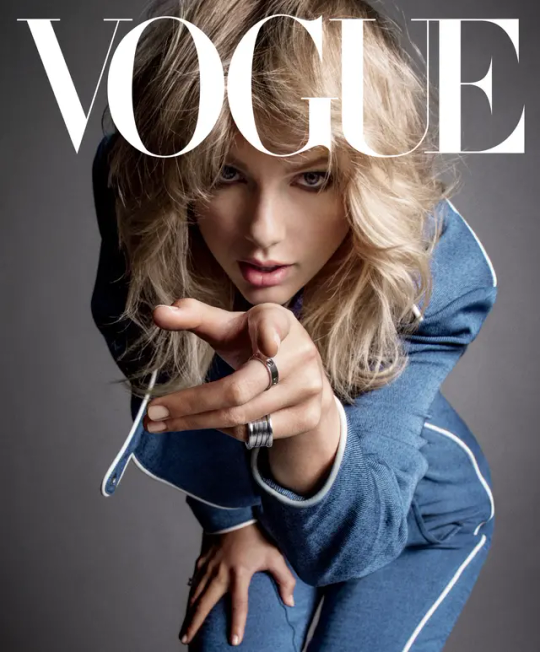
A — Allyship or Authority?
In the second and third paragraphs of the Vogue article, the author describes the star-studded, rainbow-saturated set of “You Need to Calm Down.” It’s a gay wonderland: Hayley Kiyoko shooting arrows, the cast of Queer Eye sipping tea, and Todrick Hall holding court. At the center of it all? Taylor Swift—literally cast as the sheriff of this queer town.
This visual begs the question: would all of these openly queer artists sign on to uplift and center a straight woman’s vision of queerness if it were just that—straight? Would a “sheriff” character not feel weirdly self-appointed unless it was someone already accepted by the community she’s symbolically policing for?
If Taylor were purely an outsider to the LGBTQ+ community, the optics of this video might feel off—like performative allyship bordering on appropriation. But instead, these queer creatives joined her vision. That doesn’t prove anything definitive, of course, but it does challenge the idea that Swift was simply “borrowing” queerness for optics. The role she plays in that trailer-park utopia feels more like one of quiet authority.

B — Byzantine Breadcrumbs
In paragraph six, the Vogue author confesses: “I hadn’t understood how coded and byzantine her body of work had become; I hadn’t learned, as Swift fans have, to see hidden meanings everywhere.” This is a powerful observation—and one that Gaylors have long embraced as a cornerstone of Swift’s artistry.
The word Byzantine isn’t just poetic. It’s specific. It implies complexity, secrecy, and intentional obfuscation—a storytelling style that thrives on symbol and structure. It mirrors the way Swift weaves metaphors, numbers, time-stamped references, and narrative misdirection into her public-facing work.
This is where plausible deniability enters the chat. Taylor gives her audience enough—just enough to be interpreted—but never so much that anything is definitively confirmed. She can’t be “proven” one way or another. And that’s the point. This isn’t just fan projection—it’s a blueprint. The layered, coded nature of her work invites analysis because it’s crafted to sustain multiple truths at once.
When Swifties reduce this system to “easter eggs for the next album,” it undercuts the literary, poetic, and queer-coded lineage of what she’s actually doing. She’s not just teasing projects—she’s hiding a whole life in plain sight.

C — Codes, Clues, and Calculations
In paragraph eight, the author writes: “Apprehending the Taylor Swift Universe is like grasping quantum physics.” It’s a nod to the sheer complexity of her work, but more than that, it validates the way many fans—particularly Gaylors—approach Taylor’s art: through close reading, detailed timelines, and intertextual analysis.
This isn’t a stretch. Taylor loves numbers. She codes her life in them. From referencing “Track 5” songs as emotionally significant, to dropping albums and music videos on symbolically loaded dates (like Pride Month, or Lesbian Visibility Day), there is historical precedent for believing she crafts with intention.
So when Gaylors notice the consistent use of numbers like 8 and 3—Karlie Kloss’s birthday—or see mirrored timestamps and patterns emerge across albums, it isn’t “reaching.” It’s reading. It’s noticing the very kind of symbolic complexity Taylor herself says she values.
To reduce these patterns to coincidence is to ignore the deep, ongoing conversation she’s having with her audience. She knows how to whisper through art. The question is: who’s listening?
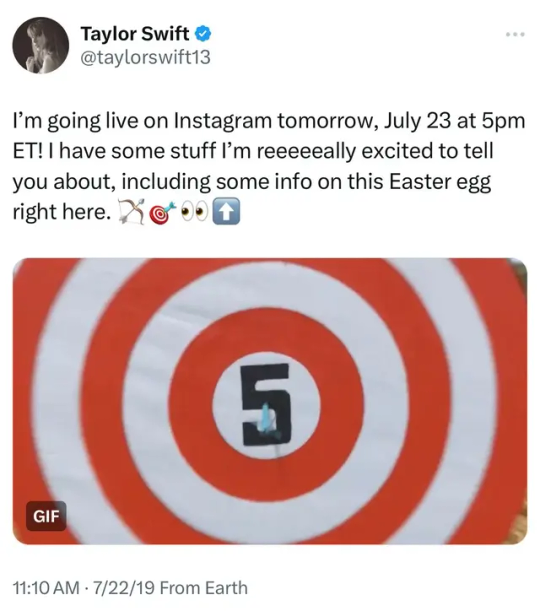
D — Dates and Declarations
In the 9th paragraph, the Vogue article notes that Lover was announced just after midnight on June 1st, the first day of Pride Month. The timing wasn’t accidental—and neither was the content. Taylor also released a letter to Senator Lamar Alexander, asking him to support the Equality Act, and posted a petition in support of LGBTQ+ civil rights. These weren’t vague gestures—they were coordinated acts of public political advocacy.
What makes this significant isn’t just that she said these things—it’s that she’d never said them this loudly before. Prior to Lover, Taylor had a documented history of quiet support: a donation to GLAAD in 2011, a pro-gay lyric in Welcome to New York, presenting Ruby Rose with an award, and even subtle visual nods like her lavender sweater in Mean. But none of that matched the scale, clarity, or political urgency of her 2019 actions.
Then there’s the author’s note that her letter was written on her personal stationery, which cheekily read: “Born in 1989. Loves cats.” If that’s the personal truth she’s putting on paper, her next sentence—“I personally reject the president’s stance”—reads differently. “Personally” doesn’t just signal belief; it signals lived experience. If she were writing from a purely ally perspective, wouldn’t it be easier to say “I support the rights of the LGBTQ+ community”? Instead, she positions the rejection as something that affects her directly.
This is part of what makes the “I recently realized I could advocate for a community I’m not a part of” statement so strange in the same interview. She’d already spent years advocating for queer people—what changed? Perhaps it’s not that she was finally advocating for LGBTQ+ people, but that she was finally speaking about trans rights, a specific subgroup she hadn’t addressed before. The specificity is important—because if she’s not part of the trans community, but is part of the LGB community, then the quote reads very differently than it’s often interpreted.

E — Enemies of Progress: Who Was YNTCD Really For?
In paragraph 10, Vogue lists the targets of You Need to Calm Down: trolls, cancel culture, homophobes, concert picketers, and those who pit successful women against each other.
But let’s pause—who was picketing Taylor’s concerts? Why were people already protesting her shows before YNTCD ever dropped?
Because her queer alignment didn’t start in 2019. For nearly a decade, she’d quietly supported queer causes, coded her music with queer subtext, and stood in solidarity behind the scenes. YNTCD wasn’t a beginning—it was a confirmation.
And it did more than call out hate. It placed her at the center of queer joy—as sheriff, no less. That imagery wasn’t subtle, and it challenged the idea that she was merely an ally.
The song also critiques how women are constantly scrutinized and compared—adding a deeper layer for someone who’s long had her personal relationships dissected under a heteronormative lens.
YNTCD made her stance unmistakable. Even if she didn’t spell it out.

F — Family Matters: “If He Was Gay, He’d Be Gay”
In paragraph 12, Swift shares a moment with close friend Todrick Hall. He asks, “What would you do if your son was gay?” Her response: “If my son was gay, he’d be gay. I don’t understand the question.”
It’s a powerful moment—especially in context.
They're sitting in a secret garden shaped like a cocoon—a space symbolizing transformation and protection. The metaphor is striking. Here’s Taylor, wrapped in this image of safety and potential change, confronted with the idea that someone close to her had doubts about where she stood.
Her realization? “I hadn’t been publicly clear enough.” But clear to whom?
Of all the marginalized communities Taylor could have highlighted, she centers the LGBTQ+ community. Not women. Not BIPOC fans. Not people with disabilities. This is who she’s focused on.
And her emotional reaction—“devastating”—isn’t just about perception. It reads as personal. If she were queer, this would be a moment of profound internal reckoning. Because being seen as an outsider to your own community is a unique kind of pain.
That’s why the answer hits different. “If he was gay, he’d be gay.” It carries the energy of someone who’s long wrestled with her own identity and doesn’t want that struggle projected onto others.
If she was gay, she'd be gay.
What’s the question?

G — Guarded in Conversation, Glowing in Song
The writer notes that Taylor’s answers on LGBTQ+ topics were “direct, not performative or scripted,” but also that she seemed tense—“like she’d enjoy [the interview] about as much as a root canal.” The exception? When the conversation turned to music. Suddenly, her “face lit up” and she began weaving melody into her speech. That’s where she’s most at home.
It begs the question: Is music the only place she feels free to speak her truth?
If her public language is burdened with risk—fear of missteps, media backlash, or violating a carefully crafted persona—then songwriting becomes her sanctuary. A protected space where she can communicate honestly, albeit in metaphor and code.
She seems guarded in speech, but in music?
She radiates.

H — Hints from the Heartland
The author of the Vogue piece acknowledges that Taylor had been sending pro-LGB signals for years—since at least 2011. And Gaylors know it goes even further back: in 2008, she was participating in anti-gay bullying PSAs and quietly supporting LGB causes long before it was deemed “safe” for someone like her to do so.
And that matters. Because she was a young country star from Nashville. We explored this in The Glass Closet post: country music has a long, fraught history with queerness. Chely Wright’s career was decimated the moment she came out in 2010. Taylor would’ve seen that play out in real time—and internalized the lesson.
So her early advocacy wasn’t just subtle. It was strategic. She laid groundwork in winks and whispers, not because she didn’t care—but because she knew the cost of being too loud, too soon.
I — In Plain Sight: A Timeline of Taylor’s Queer Advocacy
Long before Vogue 2019, Taylor Swift had already been participating in meaningful acts of queer advocacy—subtly, consistently, and often in ways that flew under the radar for casual fans. Here’s a quick timeline of what she had already done by the time this article was published:
2008 – Participated in a Seventeen magazine PSA against anti-gay bullying following the murder of Lawrence King, a 15-year-old shot for being gay.
2010 – Released Mean, widely interpreted as a song about homophobia and bullying. In the video, one character wears a lavender sweater—later referenced in the Vogue article.
2011 – Began to be more visibly supportive of queer artists and fans. Notable moments include her friendship with out lesbian musicians like Hayley Kiyoko (who later appears in her music video) and support for LGB charities behind the scenes.
2014 – Released Welcome to New York with the lyric: “You can want who you want / Boys and boys and girls and girls.” This marked one of her first overt queer-affirming lines in a song.
2016 – Publicly presented Ruby Rose (a genderfluid lesbian actress) with a GLAAD Media Award.
2017–2018 – Dedicated “Dress” on the Reputation tour to Loie Fuller, a queer icon and gender-defying performance artist.
2018 – Wrote a personal, viral Tumblr post ahead of the midterms calling out anti-LGB legislation and specifically criticizing Marsha Blackburn’s homophobic voting record. This was a major shift for a celebrity who had previously remained silent about elections.
2019 (pre-Vogue) – Donated generously to GLAAD and the Stonewall Inn Gives Back Initiative during Pride Month. She also began actively using her platform to uplift queer voices, and started the You Need to Calm Down campaign by launching a petition in support of the Equality Act. This is where the organization/policy she supported explicitly included gender identity in its mission or language and Taylor acknowledged this publicly.
These moments span more than a decade—and they are not subtle. Her engagement wasn’t a sudden pivot in 2019; it was a steady climb toward louder, more direct action.
Soon, we’ll return to the infamous “community I’m not a part of” quote that so many Swifties have latched onto. But before we get there, it’s worth recognizing: Taylor’s track record of queer advocacy was long established well before that moment.

J — Judgements and Justifications
In discussing the Tennessee Equality Act, Taylor says she “loved how smart it was to come at it from a religious perspective.” On the surface, this is a political observation—praising a tactic that reframes queer protections in a language conservative lawmakers might understand. But for a songwriter like Swift, who builds entire albums around thematic layers, this statement feels more personal. In The Tortured Poets Department, she references biblical imagery, heaven and hell, sin, redemption, punishment, and divine judgment. The emotional weight behind her lyrics—especially when dealing with shame, silence, and secrets—often echoes the internal conflict so many queer people experience growing up in religious households or communities.
Swift doesn’t just casually name-drop religious themes; she builds worlds out of them. To highlight the “smartness” of using religious justification in advocacy suggests a deeper awareness of how moral arguments are weaponized against queer people. It also implies she’s personally familiar with the pain those narratives can cause—and how powerful it can be to reclaim that language for liberation.

K — “Kicked Down by the Church” The release of “You Need to Calm Down” wasn’t just met with celebration—it triggered backlash, including from a Colorado pastor who declared Swift “a sinner in desperate need of a savior” and warned that “God will cut her down.” Beyond the absurdity of that rhetoric lies something much more serious: the reminder that queerness, or even perceived queerness, invites violent cultural policing. Some LGBTQ+ activists also questioned the suddenness of Taylor’s embrace of Pride imagery, critiquing her for corporate allyship or performative politics.
But if you’ve been paying attention—as the Vogue article subtly invites you to do—you’ll know none of this came out of nowhere. She had been quietly aligning with the queer community for years. And for a woman who had never been called a “sinner in need of saving” before, this moment was a turning point. If she received this kind of vitriol just for advocating, imagine the fallout if she openly identified as queer.
Maybe that’s why she dresses herself as the literal sheriff of a technicolor gay village in the “Calm Down” video. It’s a declaration of belonging disguised as allyship—plausible deniability in rhinestones and pastel wigs. Maybe this was her version of coming out. Or maybe it was a warning shot across the Bible Belt. Either way, the message was loud.
L — “Legacy or Liberation?”
Taylor has never been afraid to speak out—when it matters most to her. Whether pulling her music from Spotify, standing up to Apple Music, or fighting for artist ownership of her masters, she has repeatedly put her reputation on the line to challenge powerful institutions. In the Vogue interview, she explains her choice to let go of the past and focus on the future: “It was either investing in my past or other artists’ future, and I chose the future.” This quote, while referencing her business decisions, echoes another liberation she seems to be chasing—one that lives between the lines of her music and her imagery.
It’s not a stretch to read this through a queer lens. If Taylor has accepted the limits of the glass closet, she’s at least trying to leave the door cracked open for others. She’s built a career on coded confession, signaling over and over again to those who know how to listen. And still, she’s never named Gaylors as harmful or called for the conversation to stop—even while she’s called out just about everything else that’s hurt her.
People point to this article as the smoking gun of heterosexuality. But they fail to see the queerness that fills every page. If this is the definitive “she said she’s straight” moment… explain the rest of the article. Go on. We’ll wait.
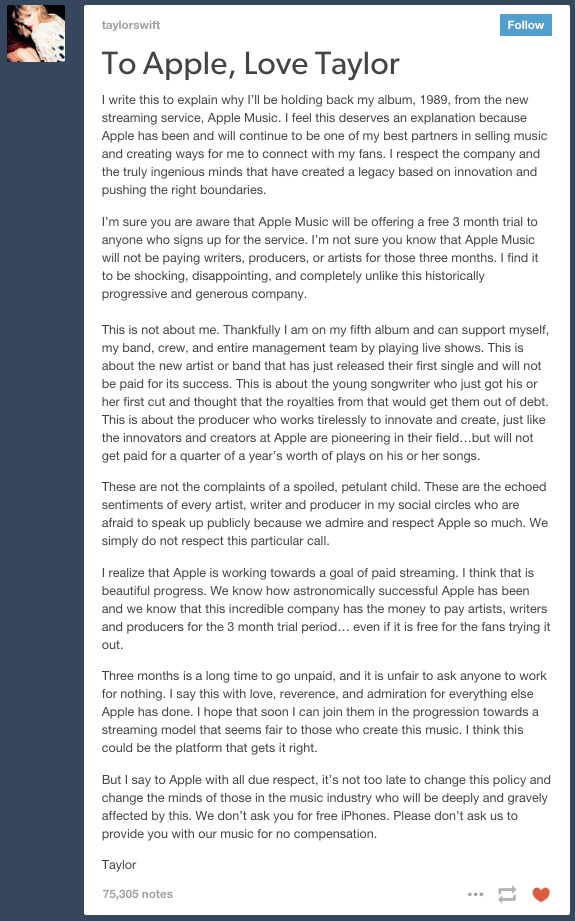
M — “Met Before the Moment”
Before we even reach the infamous quote Swifties love to use as proof that Taylor is straight, we’re grounded in a moment of bravery: her decision to take a stand in her sexual assault trial. The article recounts how she testified publicly, in open court, against the DJ who assaulted her—seeking only a symbolic $1 in damages. It’s a reminder of the way she’s used her platform to speak up, even when it’s uncomfortable or risky.
This moment of strength isn’t just about justice—it’s also about identity. It’s about taking back control of her own narrative, something Taylor has fought for time and time again. And that matters in the broader context of queerness too. The fear, vulnerability, and risk of being scrutinized, disbelieved, or minimized—it’s not the same, but it echoes the kind of high-stakes exposure that often accompanies coming out.
So when we talk about what Taylor says next, let’s not forget the emotional terrain she’s already laid. She knows what it means to be disempowered and to reclaim the story. And she knows the cost.

N — “Not a Part of the Community?”
Here it is—the quote that gets endlessly tossed around to “shut down” Gaylor:
“Rights are being stripped from basically everyone who isn’t a straight white cisgender male,” she says. “I didn’t realize until recently that I could advocate for a community that I’m not a part of. It’s hard to know how to do that without being so fearful of making a mistake that you just freeze. Because my mistakes are very loud. When I make a mistake, it echoes through the canyons of the world.”
At first glance, it seems like a straightforward disavowal. But let’s slow down and really examine it.
We’ve already established that Taylor has been advocating for LGB rights since at least 2008—from anti-gay bullying PSAs, to her GLAAD partnerships, to lyrics and symbols embedded across albums. So if she had always believed you shouldn’t speak on behalf of communities you don’t belong to… why was she advocating for queer rights all along?
The math only works if we understand that this quote is referring to her first time advocating publicly for the trans community—a specific identity group within the LGBTQ+ umbrella that she may not personally share.
Her activism in 2019—especially around the Equality Act and her statements on gender identity—was the first time she explicitly centered trans rights. So when she says she “didn’t realize” she could advocate for a community she’s “not a part of,” she may be drawing a careful line: she is part of the queer community. But trans rights advocacy, in that moment, was new territory. And for someone with her level of fame, she was terrified to get it wrong.
This reading not only makes sense—it’s supported by the timing, by her language, and by the long arc of her advocacy.
So no, this quote isn’t a denial. It’s a rare moment of vulnerability about the risks of public advocacy when you belong to some parts of a community, but not all. And for a woman who’s spent her career walking the tightrope of plausible deniability, this kind of carefully crafted phrasing is not a slip—it’s intentional.
If she believed she couldn’t advocate for people she didn’t identify with, then all her previous advocacy points to one conclusion: she does identify with the queer community. Just not every part of it.
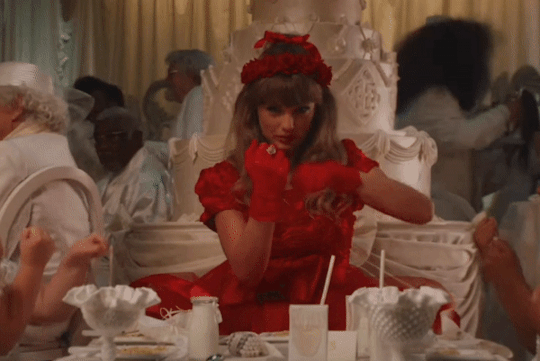
O — Omitted on Purpose: What We Choose to See
Let’s talk about timing.
On April 26, 2019, Taylor posted “ME! Out now” — the first single of the Lover era — and signed it off with hearts and rainbows. She posted it on Lesbian Visibility Day. A release date known to be significant in queer circles, posted in rainbow color palettes, launching her most colorful era yet. And that caption? “Out now.” It’s subtle. Or maybe it isn’t.
Then, she released Lover just after midnight on June 1st, the official start of Pride Month. These dates were not arbitrary. This is the same Taylor Swift whose fans currently believe she will announce Reputation (Taylor’s Version) on March 28 (3/28) because it mirrors her original Reputation announcement date of August 23 (8/23) — and that a ram mask worn upside-down in the "Karma" music video is somehow pointing to this through astrological symbolism related to Ram Day. Don’t get me wrong, I love the deep digging and cool connections just as much as anyone, but it’s the way that some things are totally acceptable to clown while others are outright rejected as nonsense.
Like… let’s pause. If that level of acrobatics is applauded and celebrated by fans, how is “Out now” on Lesbian Visibility Day somehow “a reach”?
It’s selective attention.
The fandom chooses to dismiss the simplest, most plausible clues when they point toward queerness — while simultaneously clowning for far more elaborate theories that conveniently uphold heteronormative narratives. The rainbow murals, bisexual wigs, LGBTQ+ symbolism, and carefully chosen dates from this era are too consistent to be random. And yet they're brushed off while a mirrored ram date theory spreads like wildfire.
When it comes to the Lover era, maybe the Easter eggs weren’t just hinting at a re-record or a new album drop. Maybe she was dropping something else entirely — and everyone missed it. Or worse, they chose to.

P — Perception Shift: From Girlhood to Glass Closet
In this section of the article, the interviewer shifts to a conversation about sexism, asking whether Taylor had always been aware of it. Her response is vulnerable, self-aware, and (importantly) layered. She reflects:
“When I was a teenager, I would hear people talk about sexism in the music industry, and I’d be like, I don’t see it. I don’t understand. Then I realized that was because I was a kid. Men in the industry saw me as a kid... The second I became a woman, in people’s perception, was when I started seeing it.”
This quote is essential not just for what it says about how women are treated in entertainment — but how it might also parallel her internal awakening, particularly as it relates to queerness.
When you're a kid — especially a girl — people write off your perspective. They infantilize you. You’re considered safe, nonthreatening, charming. And if you’re queer, but not yet perceived as someone who could pose a challenge to heteronormativity, your existence is easier for the world to digest. But the moment you step into adulthood, when your body is sexualized, your career becomes powerful, and your voice begins to matter… suddenly you’re “too much.” Suddenly, you’re dangerous. Sound familiar?
If Taylor entered the industry with any part of herself tucked away for safekeeping — a glass closet agreement, for example — then this realization about sexism might have dovetailed with a larger reckoning about her identity and autonomy. Not just who she was perceived to be, but what she was allowed to say, and who she was allowed to love.
That quote about songs like I Knew You Were Trouble and We Are Never Ever Getting Back Together marks a turning point in how the industry saw her — and maybe, how she saw herself. It's not hard to imagine that her emergence into “womanhood” in the public eye also came with the devastating realization that if she was ever going to live authentically, it would be on someone else’s terms.
This is why grace matters. If we allow Taylor room to grow in her awareness of sexism, why wouldn’t we offer the same space for her to process queerness — not just in others, but within herself? This paragraph plants the seed that not everything was visible to her when she was younger — but that doesn’t mean it wasn’t there. It just hadn’t yet been allowed to be seen.
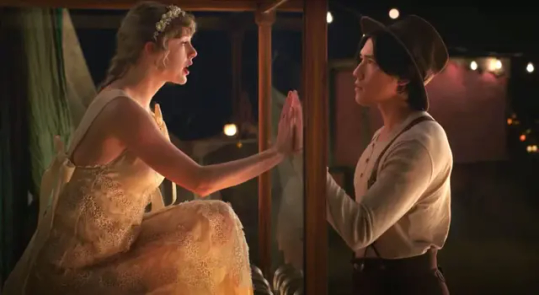
Q — Quiet as It’s Kept: The Art and Accusation of Her Songwriting
This paragraph may not scream “Gaylor” on first glance, but it offers one of the most quietly profound insights into Taylor’s artistry — and how it’s been misunderstood, minimized, and even weaponized against her.
She reflects:
“People would act like [songwriting] was a weapon I was using. Like a cheap dirty trick. Be careful, bro, she’ll write a song about you... First of all, that’s not how it works. Second of all, find me a time when they say that about a male artist...”
There’s something almost queer-coded in this experience: being punished for your method of expression, having your emotional honesty misread as manipulation, your perspective dismissed as dramatization. Taylor’s frustration here reveals just how deeply misunderstood she’s been — not just as a songwriter, but as a person who makes her private longings legible through art, only to have them distorted by the public eye.
What she creates is not a “cheap trick.” It’s a quiet art, a system of layered metaphors, symbols, personas, and lyricism — where truth lives just beneath the surface. Her music is often so personal it’s uncomfortable, but not because it overshares. On the contrary, it hides itself in plain sight. It’s legible to those who speak her language — and confounding to those who don’t.
The idea that her songs are “a weapon” implies that her truth, when unveiled, is dangerous. And maybe that’s exactly the point. If you are queer and closeted, your truth is dangerous — not because it’s shameful, but because it threatens the illusion that protects you.
Taylor isn’t just writing songs. She’s coding messages. She’s weaving grief into gowns and secrets into choruses, making it possible for a person to be understood without ever being exposed.
This quote might not name queerness directly. But it names the system that makes queer storytelling so difficult in the first place — and that alone makes it worth highlighting.

R — Rejection, Reputation, and the Refuge of Art
When the article shifts into the fallout from the Kimye scandal — Taylor’s cancellation, public exile, and retreat — we’re reminded just how brutal her relationship with the public has been. She describes the experience as catastrophic, a mass shaming that stripped her of her voice and agency. Her instinct? To make music. She says it was the only way to survive.
This coping mechanism is revealing. When the world misunderstands her, she writes. When she feels unsafe to speak, she sings. When she’s exiled, she creates a universe where she’s still in control.
It’s not hard to see the queer parallels here. Closeted people often use art to express what they can’t say aloud. When you’re queer and afraid — of rejection, judgment, or losing everything — your survival strategy becomes storytelling. You bury your truths in metaphor, hoping someone will notice. You write your way into safety.
Reputation was born out of trauma — but so were the following albums. Her entire discography is a roadmap of surviving silence. Her queerness, if present, lives in that pattern. It’s not just what she says — it’s what she has to say in order to keep going.
So when people demand a public declaration, they ignore the fact that Taylor has already given us something far more raw: her refusal to stop writing, even when the world tried to silence her. Her art is her resistance. Her survival. Her truth, coded and crystalline, waiting to be heard.

S — Silence, Stigma, and the 2016 Election
The article then turns to her silence during the 2016 election — a moment that defined how millions perceived her political stance. She explains that no matter what she said, she would’ve been torn apart. Damned if she did, damned if she didn’t. Her solution? Say nothing.
This feels like the exact bind she faces with her sexuality.
If Taylor were to come out explicitly, she risks alienating part of her fanbase, fueling media obsession, and potentially damaging the global brand she’s spent nearly two decades building. But staying silent also invites criticism — queerbaiting accusations, claims of vagueness, and doubts about her integrity.
It’s the trap many closeted people face, only magnified a million times under a global spotlight.
What’s interesting is that in the years following that election silence, she became louder about everything else — especially LGBTQ+ issues. Instead of retreating, she emerged with the Lover era: bright, bold, full of rainbows and carefully coded references. She may not have spoken in press conferences or interviews, but her art screamed louder than ever.
Taylor’s fear of saying the “wrong” thing isn’t weakness — it’s strategy. It’s survival. And it’s a strategy many closeted people know intimately. Because when your truth feels dangerous, silence becomes a kind of armor. And when you can’t say the words, sometimes a song — or an entire album — has to speak for you.

T — The Taylor Swift™ Bunker and the Burning of the Lover House
When Look What You Made Me Do dropped, much of the world misunderstood it. Critics dismissed it as petty or vengeful. But for Taylor, this was more than a clapback — it was a transformation. This was the moment she leaned into the idea of Taylor Swift™ — a constructed persona that allowed her to exist safely within the narrative, while taking control of it.
The Vogue article discusses how she built a house — a metaphorical one — to contain the many versions of herself. Each era a new room, a new reinvention. During Reputation, she built a bunker around that house. She didn’t give interviews. She retreated, but not passively — she did it with precision, choosing silence as a weapon and reinvention as her defense.
And now? We’ve watched the Lover House burn to the ground on the Eras Tour.
What does it mean to burn down the structure she’s been living inside?
Maybe the bunker — the shelter she created to weather public scrutiny, queer speculation, and personal betrayal — isn’t serving her anymore. Maybe this is a quiet rebellion, an acknowledgment that the narrative she once tried to control no longer needs protecting. She’s not hiding anymore — not in a tower, not behind metaphors, not in a rainbow-painted house. She’s setting fire to the architecture of plausible deniability, one spark at a time.
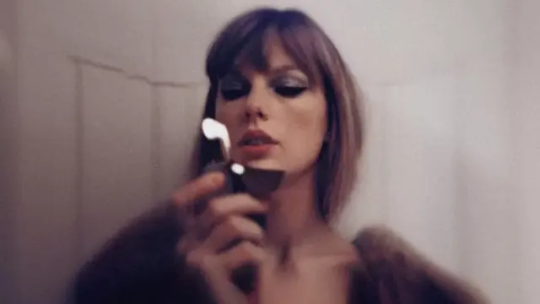
U — Underneath the Butterfly Wings
In the Vogue article, there’s a brief mention of the ME! butterfly mural in Nashville — a moment that signaled the beginning of the Lover era. But notably, the author doesn’t mention the actual date ME! was released: April 26th, aka Lesbian Visibility Day. That omission is important — because it’s exactly what plausible deniability looks like.
They do mention the intentionality behind other dates — Lover dropping at the start of Pride Month, YNTCD on Trump’s birthday — yet the most obviously coded date goes unspoken. It’s not an accident. It’s an invitation. (This makes me think about the three polaroids...)
The butterfly itself is a rich, poetic motif. A symbol of transformation, of rebirth, of self-expression emerging after a period of concealment. For Taylor, it’s a perfect metaphor — not just for the era, but for her own evolution. And painting it as wings on a wall? An invitation to stand in the middle. To imagine yourself inside the transformation.
You don’t have to decode it all. You just have to be willing to look.
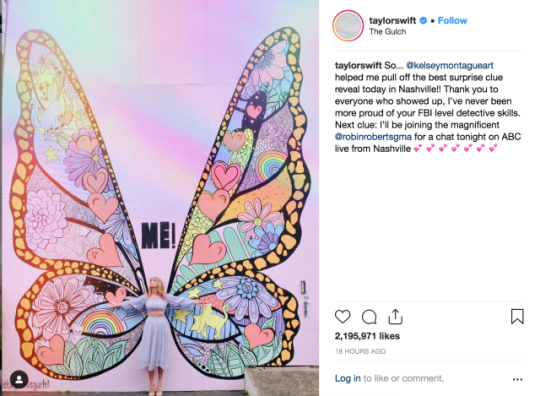
V — Vanishing Act (feat. Joe Alwyn) (kinda)
For an album that many claim is all about Taylor’s great love with Joe Alwyn… it’s kind of hilarious how absent he is from the actual Vogue feature. He’s mentioned once. In parentheses. By the narrator. Not by Taylor.
No sweeping anecdotes. No “he changed everything” soliloquy. No quotes from Taylor about their relationship. Just… blink and you’ll miss it energy.
The Lover era was supposedly Taylor’s most outward celebration of straight romantic joy — and yet the guy at the center of that narrative is completely offstage in her biggest pre-release interview? Not even a carefully scripted nod to “my amazing boyfriend who inspired this album”?
Privacy is one thing. But this? This feels like a deliberate vanishing act. Wonder why.

W — Wordless, Yet Wildly Loud
When Taylor calls Lover “a love letter to love,” it’s easy to gloss over how many shades of love that encompasses. Maddening, passionate, exciting, enchanting, horrific, tragic, wonderful… That’s not the language of a blissfully simple straight romance. That’s the language of a person who’s lived through love as survival, as loss, as transformation. It’s the language of someone who has loved deeply, maybe even when forbidden.
She describes feeling at peace after the grief of the Reputation era—an era where she famously stayed silent, building a “bunker” around herself. But silence doesn’t mean absence. It means strategy. The shell of Reputation may have been hard-edged, but inside? She was hatching something delicate and deliberate.
By the time Lover bloomed, Taylor wasn’t just reemerging. She was writing in full technicolor. And yet… still not saying it outright. This is the magic of her authorship: speaking loudly through subtext, through metaphor, through music. The story was never gone. It was just written in a language only some were listening for.
youtube
X — X-Ray Vision: Seeing Through “The Man”
When Taylor introduces The Man as a “thought experiment,” it’s easy to read it as a feminist anthem—and it is. But it’s also something more queer, more layered. The bridge is what really breaks the binary: “What’s it like to brag about raking in dollars and getting bitches and models…” This isn’t just about misogyny. It’s about power, performance, perception—and maybe projection.
What if she’s not imagining herself as a man, but imagining what it would feel like to live her actual life openly, if she were afforded the protection of maleness? The success, the swagger, the dating history, the freedom to be sexual, powerful, and unapologetic. So when she flips the mirror—“They paint me out to be bad / So it’s okay that I’m mad”—you realize she’s not just mad about double standards. She’s mad about what she could never say out loud.
If she were “the man,” maybe the things she’s done—raking in dollars, chasing models, reclaiming power—wouldn’t have to live under so much scrutiny. Or metaphor. Or plausible deniability.

Y — Yearning for Recognition: Loie Fuller and the Queer Artistic Lineage
When Vogue’s writer suggests that Loie Fuller may be the “most illuminating clue” to decoding both Reputation and Lover, it’s not just an offhand observation—it’s a revelation. Fuller, a queer icon of performance and illusion, was known for using light, shadow, and fabric to transform her body into living poetry. Her dances were about metamorphosis, concealment, emergence. Sound familiar?
Taylor honored Fuller on the Reputation tour Jumbotron and carried her motifs—serpents and butterflies—through to Lover, making it crystal clear that this reference wasn’t just about artistic ownership. It was about transformation and identity. About queerness.
Loie Fuller was a master of the “hide-and-seek illusionist game.” She dazzled and disappeared in the same moment. And what has Taylor done, if not mastered that same art? She's evoked symbols, created personas, coded her stories in velvet-lined metaphors—and paid tribute to queer artists along the way, often without her fandom realizing the depth of the gesture.
So why don’t more Swifties connect the dots? Why don’t they learn from the artists she literally projects on screens during her shows? Maybe because to do so would require acknowledging a legacy they’ve never been taught to look for. But Taylor is trying. She’s leaving us a syllabus. And Loie Fuller? She’s chapter one.

Z — Zooming Out: The Dollhouse, the Lover, and the Open Ending
As the Vogue article closes, Taylor delivers one of its most chillingly vivid metaphors: superstardom, she says, is like living in a dollhouse—a glass box where anyone can "ship you with who they want," decide who your friends are, and track your every move. The phrasing is razor-sharp, almost too articulate to be off the cuff, and it perfectly encapsulates the trap of fame. But in the context of everything else this article has covered—rainbows, butterflies, secret gardens, queerness, plausible deniability—it takes on another dimension entirely.
When she calls herself a baby doll in “ME!” and promises you’ll never find another like her, we’re reminded of that same dollhouse. A curated, polished version of herself, smiling behind glass. And yet, the lyrics wink at the queerness of desire: “You can want who you want / boys and boys and girls and girls.” She sings that line in Welcome to New York, but she lives it in the margins of her work—always teasing, always performing, always keeping the truest version of herself just out of reach.
This final image—of a woman fully aware she’s being watched, packaged, and dissected—feels like a deliberate warning shot. It's not a confession. It’s a dare. And now that the Lover house has burned down, the question remains: What was she trying to escape from? And what—if anything—is she finally ready to reveal?
That’s the question the article leaves us with. And it’s the question we’re still asking.

Conclusion: The ABCs of Plausible Deniability
When I first sat down to comb through Taylor Swift’s 2019 Vogue interview, I did what Taylor has taught me to do—I grabbed a highlighter. And as I read, I found 26 moments that stood out, 26 points that deserved more attention, 26 reasons why this article is far richer than the one sentence people love to cherry-pick as their “gotcha” against queer interpretations of her work.
So I took a page out of Taylor’s book. Hey kids, spelling is fun! And suddenly, the A-Z structure felt like the perfect way to break this all down. Because if there’s anything I’ve learned from Taylor, it’s that details matter, words are chosen with precision, and if you take the time to look closely, there is always more to the story.
The 2019 Vogue interview is not a smoking gun that “shuts down” Gaylor. It is a dense, layered, and coded piece of work that mirrors the way Taylor has always built her narrative—through plausible deniability, careful omissions, and a delicate balance of what is said and unsaid. This article deserves so much more consideration than one sentence that gets wielded against queer readings while everything else—from the trans advocacy, to the Loie Fuller references, to the calculated dates, to the butterfly and cocoon metaphors—is ignored.
Taylor Swift doesn’t do anything by accident. Not in her lyrics, not in her Easter eggs, not in her carefully crafted public image. So why would she accidentally load an entire profile with queer subtext, nods to hidden figures, and a narrative about metamorphosis and liberation?

I’ll leave you with this: at the end of the Speak Now prologue, Taylor signs off with a little smirk—“P.S. To all the boys who inspired this album, you should’ve known ;)”
And after reading this article as closely as I have, all I can say is: P.S. To anyone who thinks this interview ends the conversation… you should’ve known. ;)
#gaylor#kaylor#lgbetty#taylor swift#friend of dorothea#swiftgron#friends of dorothy#vogue magazine#taylor swift lover#taylor swift lyrics#deep dive#lover#reputation#midnights#yntcd#ME!#Youtube
34 notes
·
View notes
Text
Blue top, purple skirt, pink boots..... Hmmmm those colours remind me of something......
#Taylor Swift#1989#eras tour#gaylor#im half kidding but its so fucking funny#omg someone on the live said it looked like the yntcd hair 😭😭
42 notes
·
View notes
Text

Soo the English [CC] on Disney puts it as GLAAD! ☺️
42 notes
·
View notes
Text
Taylor Swift, my favourite underground indie artist.


20 notes
·
View notes
Text
It's been a long time coming but...
The Lover Tour!
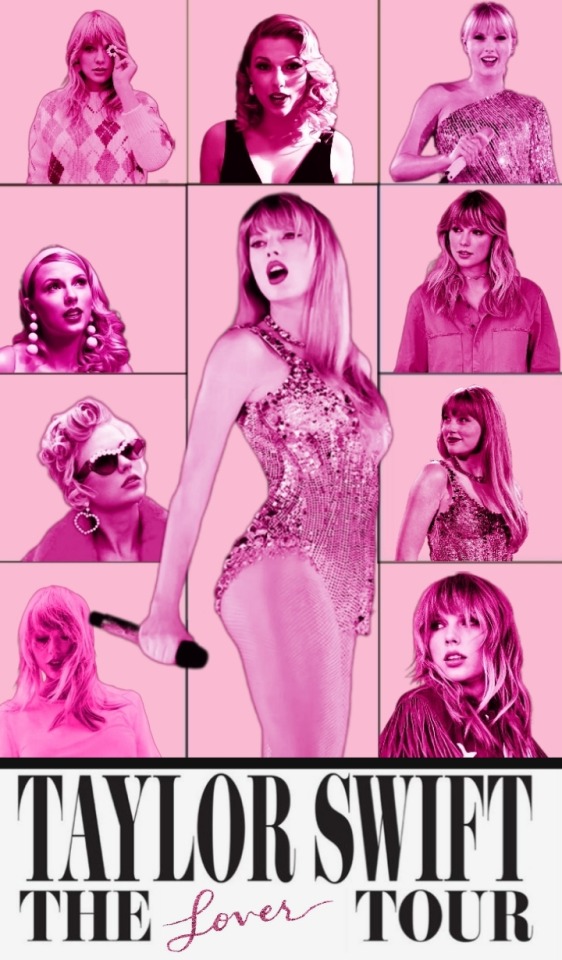
Made by ME! (bluewhiteseagull)🩷
#taylor swift#swifties#taylornation#taylor nation#swiftie4life#my collage#taylor swift wallpaper#lover taylor swift#lover photoshoot#lover eras tour#lover era#lover mv#yntcd mv#ME! MV#The Lover Tour#made by me
71 notes
·
View notes
Text


zurich n2
#taylor swift#the swiftie tag#userrcmanticpoetry#tscreators#tswiftedit#networkthirteen#tswiftgif#tswiftdaily#usertaylorswiftdaily#mine.#tegan .gif#zurich n2#song: yntcd#you need to calm down#era: lover#lover#era: eras#the eras tour
64 notes
·
View notes
Text


@tolerateit EDITING PROMPT OF THE MONTH: Summer
You Need To Calm Down
#my edit#my gifs#editingpotm#taylor swift#tswiftedit#tswift#you need to calm down#yntcd#lover album#tw fire#tsusermeggie#tsuserkatie#tsusermels#hauntedbythelook#cbhf#tusertaylor#userkarolina#usergoose#dailymusicqueens#music#dailymusicians
80 notes
·
View notes
Text
#swiftpolls#* my polls#* taylor swift#* active polls#* lover era#* lover double elimination#lover#you need to calm down#yntcd#polls for swifties#taylor swift polls#taylor swift#ts polls#poll bracket#tswift
9 notes
·
View notes
Text
The way she’s once again including herself in the lgbtq community. She’s literally a friend of dorothy (x)
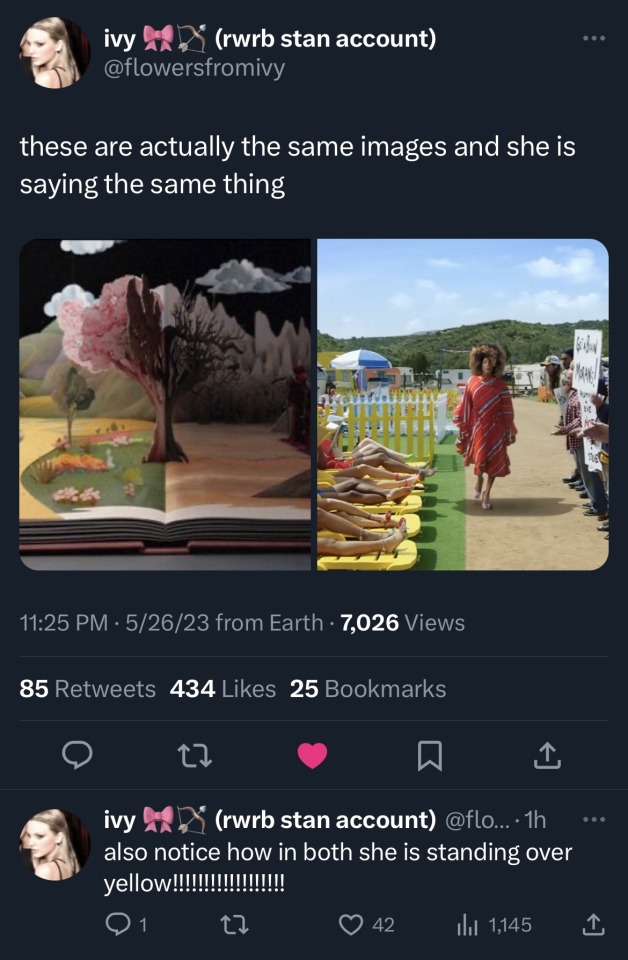


400 notes
·
View notes
Text
you need to calm down

you’re being too loud

and i’m just like

uh oh

uh oh

uh oh

uh oh

uh oh

#help I should not have laughed that much when I thought of this oml it’s so stupid#and I know that’s not the lyrics#🪪 here’s my artistic license#dps#dead poets society#dps boys#dead poets fandom#dps fandom#dead poets#neil perry#dead poets society fandom#yntcd#you need to calm down#taylor swift
24 notes
·
View notes
Text
109 notes
·
View notes